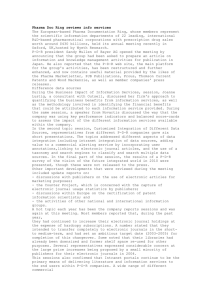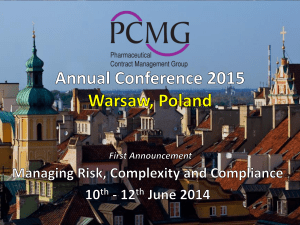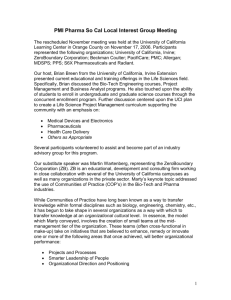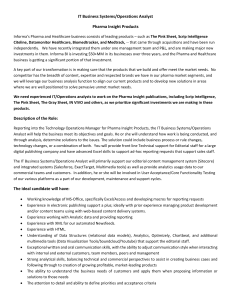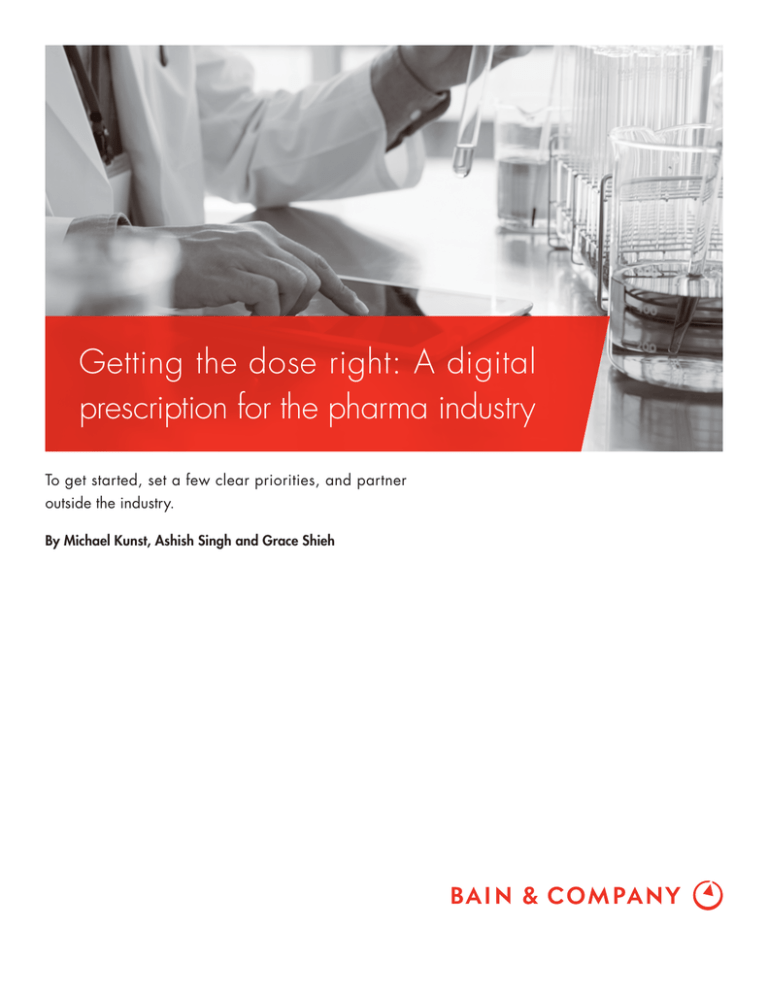
Getting the dose right: A digital
prescription for the pharma industry
To get started, set a few clear priorities, and partner
outside the industry.
By Michael Kunst, Ashish Singh and Grace Shieh
Michael Kunst is a partner with Bain & Company based in Munich, and he
leads the firm’s Healthcare practice in Europe, the Middle East and Africa.
Ashish Singh is a partner with Bain & Company in Boston, and he leads the
firm’s Global Healthcare practice. Grace Shieh is a partner with Bain & Company
based in the Shanghai office, and she leads the Asia-Pacific Healthcare practice.
The authors would like to give special thanks to Bain & Company Advisor
Simon Kennedy and Iris Danke, a principal in the company’s Zurich office, for
their guidance and contributions to this article.
Copyright © 2015 Bain & Company, Inc. All rights reserved.
Getting the dose right: A digital prescription for the pharma industry
After a decade of sitting on the sidelines, the healthcare
industry is now rapidly adopting digital technologies. In
two years, 93% of US doctors will be using electronic
medical records—up from 30% two years ago—and 97%
will have electronic access to treatment protocols, more
than double the rate in 2011, according to Bain research
(see Figure 1). For pharma companies, which are also
late to the game, this is a call to action.
technologies through its joint investment company with
Qualcomm Ventures. It also has partnered with Walgreens
to recruit participants in clinical trials from the pharmacy’s
100 million customer database. So far, however, pharma
industry initiatives have mostly been scattered. To deliver
significant gains along the entire complex, data-heavy
value chain, companies have to better link data, analytics,
workflow and connectivity, both internally and externally.
It‘s not only pharma customers that are changing. Digital
tools and data are poised to transform the pharma industry. They enable a faster, cheaper and more effective
approach to drug research and development, as well as
production and commercialization. Real-world data has
already begun to disrupt the traditional approach to medical reimbursement as payers demand evidence of efficacy beyond the lab. In the future, only companies that
use real-world data to demonstrate superior outcomes
for new drugs will generate attractive returns.
Now the pace of change is quickening. US venture investment in digital healthcare quadrupled over the past four
years, reaching more than $5 billion in 2014, and IBM
Watson and Apple have joined the race with projects
aimed at creating and curating treasure troves of healthrelated data. Over the next five years, most US healthcare
providers and payers will go digital. Pharma companies
that develop well-coordinated digital strategies and partnerships in tandem will have the opportunity to help codesign
the industry’s future.
Many companies have begun using digital tools in parts
of the business. Novartis, for example, is investing in
early-stage digital health companies and beyond-the-pill
Building a successful digital strategy
Creating an overarching digital strategy is no easy task
amid all the noise about digital transformation. Some
companies feel overwhelmed and paralyzed by the challenge. Others are rushing in too quickly and without setting priorities. At one global pharma company, we found
more than 200 digital projects and 2,000 related websites, many of which lacked the necessary coordination.
The leadership team had no overview of the scattered activities and, as a result, derived little benefit from them.
Figure 1: Providers have invested in new tools
to support more systemized care
New clinical tools and practices are being adopted quickly,
and this trend is expected to continue
Telemedicine
52
Transparency initiatives
62
Remote patient monitoring
Predictive analytics
75
Comparative effectiveness data
68
Wellness programs
81
Care coordinators
81
Patient adherence initiatives
63
Physician extenders
Electronic access to
treatment protocols
Electronic medical records
86
97
93
95
Standard treatment protocols
0
Used 2 years ago
Even strategically interesting projects risk budget cuts
if management fails to set clear digital priorities. One
US pharma company set up a listening center to survey
social media to help it better understand what consumers
were saying about its products. But the test project was
not linked to a coordinated strategy. So, when the manager in charge tried to extend the listening center platform,
he failed to secure funding because management was
not aware of its benefits.
59
20
40
60
80
Percentage of physicians
Use now
100%
Digital health is a broad and complex field, but it’s not a
black box. We suggest companies break it into a manageable number of thematic clusters that allow leadership
teams to speak a common language and have an informed
Expect to use in 2 years
Source: Bain Front Line of Healthcare Survey, January 2015
1
Getting the dose right: A digital prescription for the pharma industry
Embrace real-world data
discussion. For some firms, there will be 20 relevant
clusters, but for others, it might be as high as 40. Together, the clusters represent a map of digital opportunities; they help determine which areas of investment
are likely to deliver the greatest competitive edge across
the entire pharma value chain (see Figure 2).
Advanced analytics can speed the development of more
effective pharmas, but most pharma companies lack the
real-world data to benefit from analytics, modeling and
simulation. Combined with the right tools, data becomes
a torch in the darkness. Without it, all research trends
look equally interesting. Those who are first to harness
real-world data on a large scale will reap big gains. The
top 10 pharma companies could each unlock $1 billion in
value annually by tapping into this resource, according to a recent forecast by IMS Health.
Big Data analytics, for example, enables pharma companies to harness real-world data to accelerate drug discovery while also providing valuable health economics and
outcomes data for access, pricing and, potentially, safety.
The goal is to select a few high-priority areas that represent the highest return for the lowest cost, risk and investment of time, based on the company’s strategy. By selecting
a few concrete projects, leadership teams can move
forward without getting lost in a digital maze.
But even the biggest players will need strategic partnerships to obtain it. Clinical trials, pharma companies’
main source of information, represent only a sliver of
the world’s healthcare data. As the industry and governments adopt data tools such as electronic medical records
and patient reporting platforms, they will increasingly
partner to create rich troves of real-world data.
There is no right answer about where to start the digital
journey. As a growing number of pharma companies
start down the trail, though, we see two areas where they
are gaining good traction: working with real-world data
and building a great digital experience for customers,
patients and other stakeholders.
Bayer invested in generating real-world data for its anticoagulant Xarelto to address concerns about bleeding as
Figure 2: Digital health is a broad and complex field; trends can be summarized in distinct clusters
Pharma value chain
Big Data/
analytics
Consumer
engagement
Data exchange
• Medical
information
• Smart
factory
• RWE
• E-safety
• Digital
supply
chain
• Genomics
Sales/account
management
Marketing
Commercialization
Access/HEOR
Logistics
Production
Pharmacovigilance
Product Supply
• Modeling/
Simulation
Self-health
Diagnosis
• RWE
• Fitness tracking
• Omnichannel
• Patient education
• Remote
monitoring
• Digital diagnostics
• Genomics
• E-clinical
• EMR
Cross-functional
Devices
Personalization
Medical
affairs
Medical
Clinical
development
Translational
medicine
Key tech trends
Discovery
R&D
Customer pathway
• Advanced
analytics
• E-training
• Telemedicine
• Cybersecurity
• Remote monitoring
A sample of the 20–40 digital health themes that may be relevant for each company
Note: RWE=real-world evidence
Source: Bain analysis
2
Treatment
Getting the dose right: A digital prescription for the pharma industry
Personalized marketing harnesses digital connectivity
and data to address the individual consumer directly in
real time and provide offers that are based on understanding individual behavior and preferences. Examples include
focusing on over-the-counter treatments for sports enthusiasts or pregnant women. Merck, for example, took a
majority stake in Physicians Interactive, which develops
advanced analytics and marketing tools to better engage
with physicians.
a side effect. It used data from existing disease registries
and funded new studies. The real-world trial of 6,784
patients showed 96 out of 100 patients did not experience any major bleeding or related side effects. The trial
helped convince payers to reimburse patients and improve
the drug’s rapid acceptance in the market.
Real-world data are particularly important for pharma
companies with pipelines focused on treatments for rare
diseases, which in turn have smaller markets and, therefore, high prices. To reach the appropriate patients,
companies need to access or create data. One way to
accomplish this is to offer genetic screening for family
members. With pulmonary hypertension, screening of
high-risk patient groups can help increase diagnosis
rates and enable earlier treatment.
Some pharma companies are piloting electronic recruitment of patients for clinical trials. Others are building
online communities around patient education. To participate in all those interactions with their customers more
effectively, however, pharma companies need a range of
capabilities, including access to natural history data and
social media, the ability to process these complex data,
participation in risk evaluation and mitigation strategies and prior-authorization platforms, and the provision
of genomic, phenotypic and other diagnostic platforms.
To harness real-world data, companies need a comprehensive digital platform that integrates internal data with
external data systems, linking, for example, regulatory
affairs, clinical research and marketing. Most importantly,
the platform needs to include capabilities to semantically
normalize and clean data from vastly disparate sources
that are intended for widely varying uses. That’s a huge
challenge given the structure of existing IT systems.
Becoming a digital forerunner
Real-world data and the digital customer experience are
only two of 20 to 40 strategic themes that may be relevant
for each company. We highlight these two in particular
because we see a handful of digital forerunners in the
pharma industry gaining a competitive edge by building
expertise around them. But a digital strategy can impact
the entire value chain. Improved transparency with customers and suppliers, for example, can help companies
minimize working capital and improve forecasts.
Build a digital customer experience
In a new digital world, winning means getting closer to
customers, patients and other stakeholders by offering
them a positive digital experience. Bain research shows
physicians already spend significantly more time online
for professional reasons than with pharma sales representatives. As payers and providers increasingly seek medical
information online and embrace outcomes-driven healthcare, it’s important that pharma companies participate
in these new models of clinical decision making.
Some leadership teams may decide on a more aggressive
approach, placing bigger bets and moving faster. The
challenge is finding the right balance between staying
true to the company’s core strengths, focusing on specific
strategic needs and harnessing digital opportunities to
smoothly integrate old and new approaches. Below are
a few guidelines to keeping in step with those leading
the transition:
An omnichannel approach and personalized marketing
can help companies build a digital customer experience
and increase their reach while significantly raising return
on marketing and sales investments. Cost-effective technology tools can help companies move from a siloed to an
integrated view of customers, ensuring messages are consistent and aligned as communication channels proliferate.
•
3
Sponsor from the top. Developing a digital edge is
a strategic issue. To gain access to real-world data
and advanced analytics, pursue partnerships and
trend scouting. A lot of innovation is happening
Getting the dose right: A digital prescription for the pharma industry
Time to act
outside the industry—no pharma company can go
it alone. Digital is also a cross-functional theme that
requires collaboration across the internal functions.
Strong engagement from the top of the company
ensures that the investment in digital projects delivers comprehensive gains.
•
•
•
•
•
Digital technologies will bring many changes to the pharma industry, but they will not radically disrupt the business model. Pharma discovery and development, medical
and safety, along with manufacturing and commercialization, will remain highly regulated, as well as capital
and expertise intensive. Digital tools, however, will create
new opportunities to develop competitive advantage
across the entire value chain.
Develop your digital muscle. Build or acquire the
capability to gather, structure and analyze massive
amounts of data, both inside and outside the company. Replace isolated IT islands with an integrated
digital strategy that allows information to flow across
all functions, including the supply chain. Create a
smooth digital customer experience.
The pharma industry’s core strength is investing in
early-stage technologies and basic science. Investing
in digital capabilities is an equally strategic long-term
investment. The following questions can help leadership teams sharpen their focus on a digital strategy:
Invest in a test-and-learn approach. Once you have
selected a few high-priority digital themes, launch
lighthouse projects that can help build organizational
capabilities in digital and create a blueprint for further rollout. Ensure dedicated central funding.
Create a corporate digital healthcare incubator. Forerunners are setting up incubators to oversee digital
initiatives. One European pharma company has
launched a digital health incubator with a dedicated
budget to run a number of high-impact lighthouse
projects. The incubator designs and tracks the progress of each initiative.
Adopt an entrepreneurial mindset. A traditional
short-term return-on-investment mentality will undercut the kind of test-and-learn approach that is
critical to helping companies harness the power of
digital technologies. Lighthouse projects should be
managed as venture investors manage a portfolio of
start-ups. Some will succeed and some will fail, but
all the lessons learned are valuable.
•
Do you have a common definition of what digital
means for your company? What do you want to
achieve with data, and what specific actions does
this process encompass?
•
Has the leadership team identified two to four
digital areas that will have the biggest impact on
the company’s business and initiated a few lighthouse projects? Do you have extra funding for these
learning projects?
•
Do you know which technology partners are relevant for the company?
•
Do you have a plan to develop digital talent?
•
What is your digital operating model? Are digital
tools embedded throughout the organization?
Creating a digital strategy takes time. So far, no company
has developed a comprehensive model for the pharma
industry, but many are eyeing the prize. Companies that
set clear priorities now will be able to cut through the
digital noise and develop competitive advantage in a
changing landscape.
Design a digital strategy to support corporate strategy.
There’s no uniform digital strategy for the pharma
industry. Tailor your digital strategy to reinforce
your corporate strategy.
4
Shared Ambit ion, True Results
Bain & Company is the management consulting firm that the world’s business leaders come
to when they want results.
Bain advises clients on strategy, operations, technology, organization, private equity and mergers and acquisitions.
We develop practical, customized insights that clients act on and transfer skills that make change stick. Founded
in 1973, Bain has 53 offices in 34 countries, and our deep expertise and client roster cross every industry and
economic sector. Our clients have outperformed the stock market 4 to 1.
What sets us apart
We believe a consulting firm should be more than an adviser. So we put ourselves in our clients’ shoes, selling
outcomes, not projects. We align our incentives with our clients’ by linking our fees to their results and collaborate
to unlock the full potential of their business. Our Results Delivery® process builds our clients’ capabilities, and
our True North values mean we do the right thing for our clients, people and communities—always.
Key contacts in Bain’s Healthcare practice
Americas
Ashish Singh in Boston (ashish.singh@bain.com)
Prilla Schenck in Chicago (priscilla.schenck@bain.com)
Asia-Pacific
Grace Shieh in Shanghai (grace.shieh@bain.com)
Europe,
Middle East
and Africa
Michael Kunst in Munich (michael.kunst@bain.com)
Nathalie Fetzer-Hoernig in Frankfurt (nathalie.fetzer-hoernig@bain.com)
For more information, visit www.bain.com


